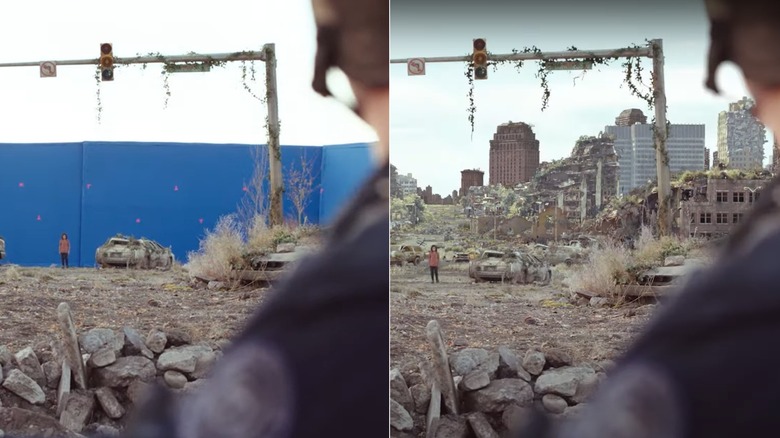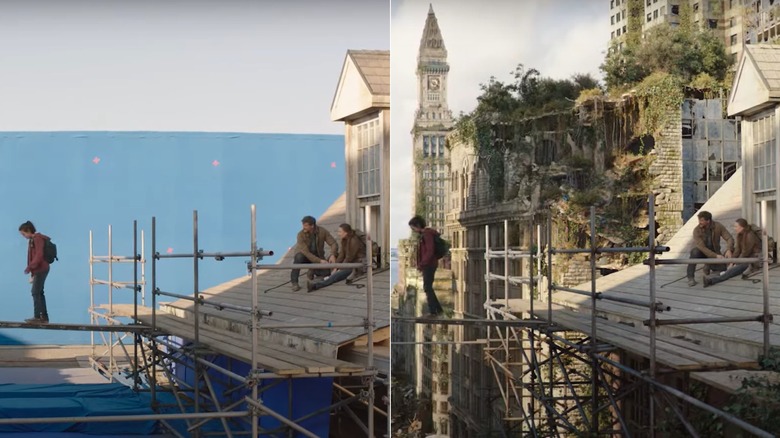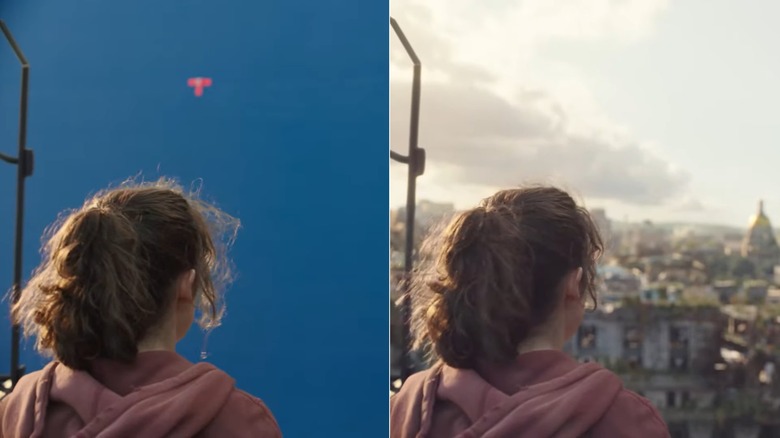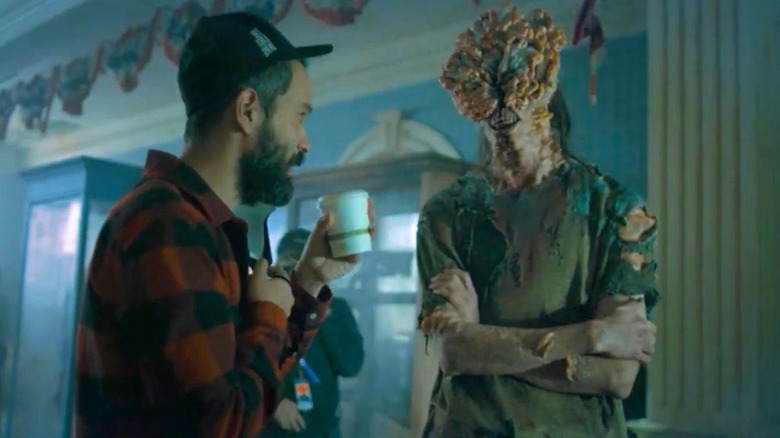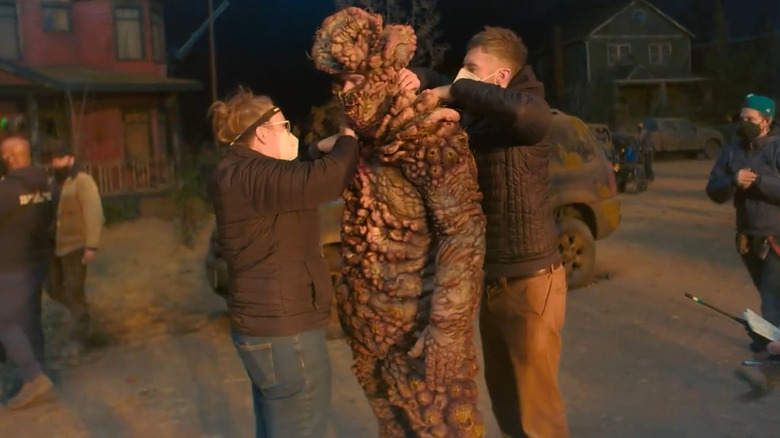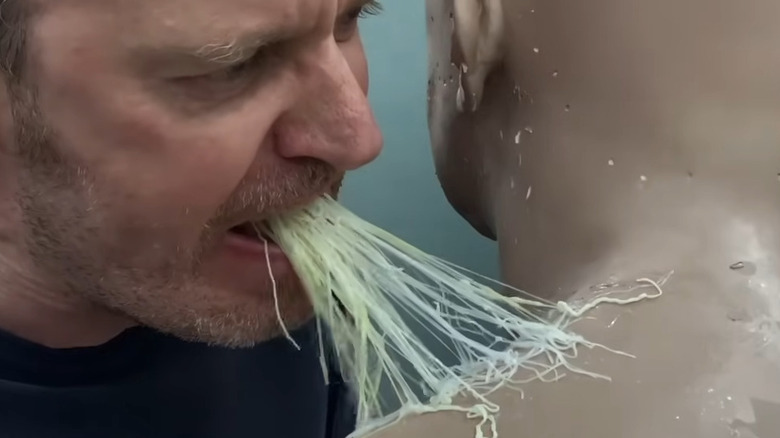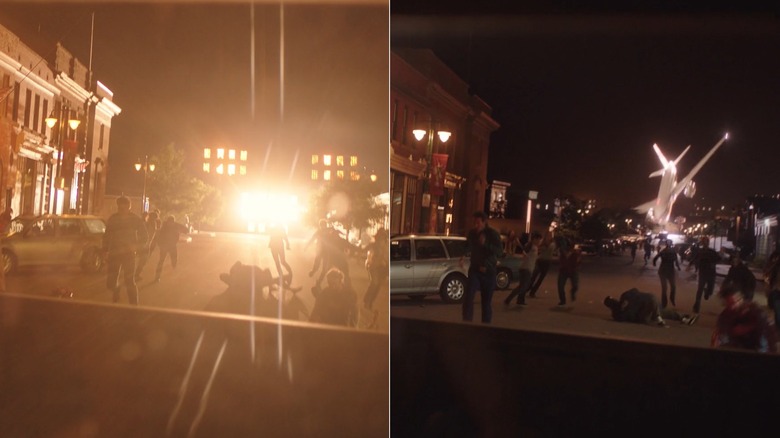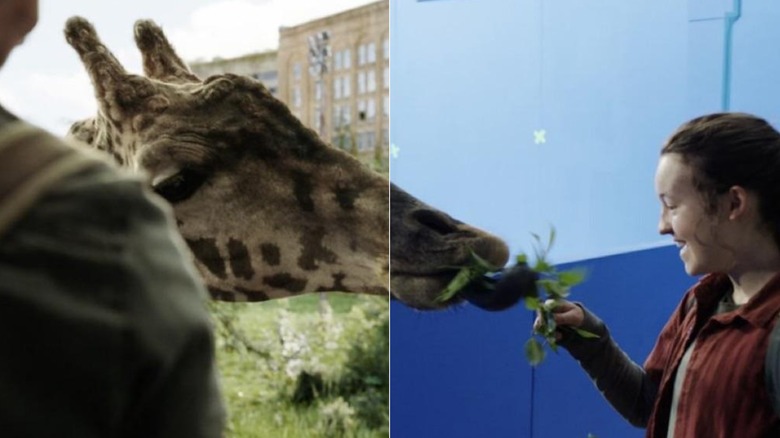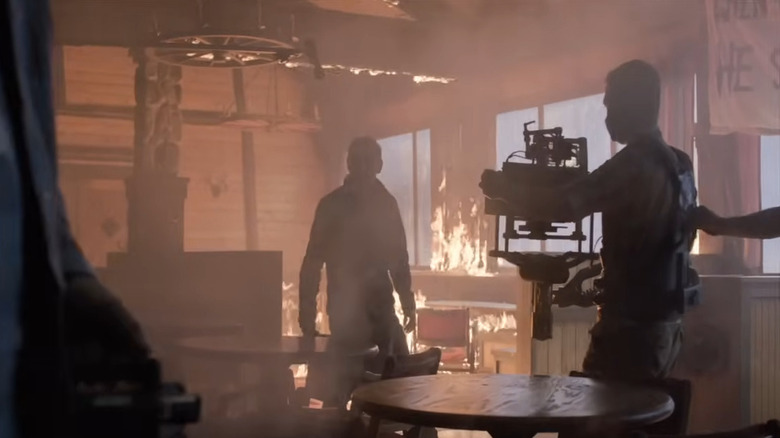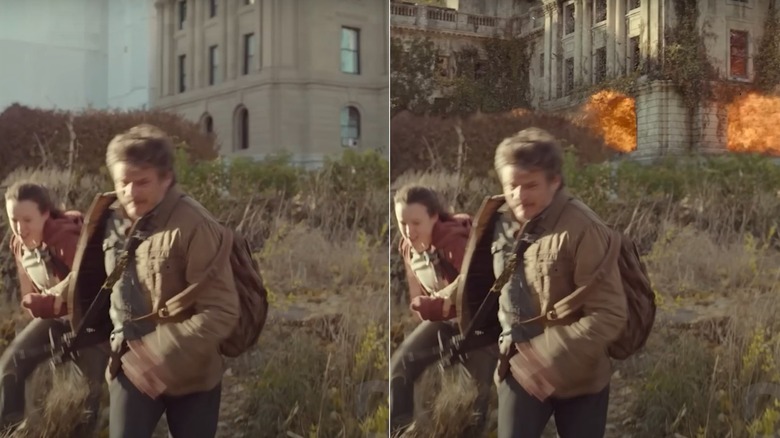What The Last Of Us Looks Like Without Special Effects
"The Last of Us" is a visually striking wonder, bringing to life a post-apocalyptic world filled with terrifying mushroom-themed zombies. Fans of the video games will find ample Easter eggs, but anyone can start watching the series even if they're not a gamer and be drawn in. It takes a genuine army to pull something like this off; otherwise, the show would look very different from how it does on Max.
"The Last of Us" is a showcase of what's possible when a production utilizes the perfect combination of practical and visual effects. Naturally, only so much can be done safely in real life with actors present, but you may be surprised to learn how much — especially when it comes to the infected — is done in-camera. Not only is it cool to see the prosthetics in real life, but it makes the VFX team's job easier by having more to build upon rather than creating a broken world from scratch.
Some top visual effects houses plied their trade on "The Last of Us," including DNEG, Important Looking Pirates, and Wētā FX. Taking a peek behind the scenes of the critically acclaimed show helps put you in the actors' shoes. It may seem like they're looking at the total annihilation of the planet, but in reality, it's a lot of blue screens most of the time. Here's what "The Last of Us" looks like without all the special effects.
Blue screens were used for the cityscapes
When we first meet Joel (Pedro Pascal) in 2003, he's living in Austin, Texas, but then he goes to a secluded quarantine zone in Boston before breaking out and taking Ellie (Bella Ramsey) on a cross-country journey. That's a lot of different areas, and what made it all the more challenging is that the production wasn't in the United States for most of filming. Filming largely occurred in Alberta, Canada, but they still had to make it look like Joel and Ellie were going all over America.
This often involved the VFX teams going to the actual cities and photographing them so that they could recreate the landscapes for the show. CG supervisor Melaina Mace of DNEG told Art of VFX that they "created a number of generic destroyed buildings that could be re-used from multiple angles to fill out our background city." It sounds like minor background images could be present in one city to the next, which means any eagle-eyed fans may want to keep their eyes peeled on rewatches to see if any towers look too similar.
However, don't expect to see entire streets that look the same. Alex Wang, a visual effects supervisor for "The Last of Us," told Awards Radar that co-showrunner Craig Mazin "also wanted a sense of change," adding: "From a visual effects standpoint, it was very bespoke between each episode to make sure that the qualities felt special and different within each episode." They clearly did a lot of research, though it wasn't always enough to appease viewers. For example, many "The Last of Us" fans weren't buying the series' Boston landscapes, largely because there's no mountainous forest 10 miles west of the city as the show claims.
VFX built upon pre-existing cities to show how society decays
For "The Last of Us," it wasn't enough to recreate American cities as accurately as possible — it was also a matter of showing what those cities might look like after 20 years of degradation. Buildings would become wrapped in moss while vines and other foliage cover cars. To do this, the VFX team sometimes took real-life locations and added layers of damage on top of them.
For example, there's one scene where Joel, Ellie, and Tess (Anna Torv) are walking through what's supposed to be a Boston street. In actuality, it's in a part of Edmonton that naturally doesn't look like it's been through an apocalypse. Instead of creating a destroyed cityscape via CGI, the VFX team took real buildings and then utilized matte painting and camera projection mapping to add vines, broken glass, and whatever else was needed to show how different the world has become.
In DNEG's VFX featurette, there are some before and after shots that show the process of layering a city, and you can see how the vehicles covered in overgrowth were really on the set. Layer by layer, the VFX team added more destruction. This goes as far as making the sidewalk look like it's been totally overtaken by nature. It's a lot of work for a single shot, but it's not surprising when you consider that "The Last of Us" made history as Canada's largest production ever.
The iconic plank scene used a blue screen and crash mats
Seeing as "The Last of Us" is based on a video game franchise, there are certain moments fans expect to translate into the new medium. One of those is when Joel lays out a plank for Ellie to cross buildings. It's symbolically significant, as it shows how Joel and Ellie will need to work together if they're going to make it out of this journey alive. It's also a visually striking moment, as the player gets to see the ruins of Boston from a unique angle. Translating this into the show meant utilizing some of the aforementioned techniques.
To create the iconic scene, a big blue screen was placed in the background and blue crash mats were put directly beneath the plank for safety. From a side angle, Boston's Custom House Tower is added to the background along with the harbor. The VFX team had its work cut out for it in creating the landscape. "We did go to Boston and capture LiDAR [Light Detection and Ranging], street level, and drone photography, so when we're creating that world it felt like Boston," Alex Wang told Animation World Network. "If you look closely, there's wind movement and different species of vegetation. It's detail after detail."
The only major difference between the show and the game is the time of day: In the game, the sun has already set, while the show has Ellie walking the plank in the middle of the afternoon. It's unclear as to whether there was any practical reason for this, but if a VFX team is going to spend all that time meticulously recreating Boston, then they probably wanted to show it off in all its glory.
The epic view that Ellie admires is really just a big blue screen
After Joel and Ellie get out of the quarantine zone, the pair take a moment to appreciate the Boston skyline. It comes toward the beginning of the first season, and it's really the first moment where the audience sees the two bonding, setting up their emotional journey in the season to come. Joel asks Ellie if it's everything she's imagined, to which she responds, "Jury's still out, but man, you can't deny that view."
While it looks pretty in the show, it's amusing to think that Pedro Pascal and Bella Ramsey weren't looking at anything during filming. The two simply stood in front of a blue screen, imagining there was some beautiful landscape in front of them. At least they had the game as reference to imagine what was out there and how it would bring these two characters together. If anything, it's a testament to these two talented actors that they were able to invoke emotion with nothing to work with.
The infected were brought to life using a mixture of practical and digital effects
You definitely wouldn't want to run into one of the infected from "The Last of Us" in real life. These are humans who have been assimilated by the cordyceps fungi and have slowly devolved into monstrous entities. However, on the set, you might have seen one hanging out sipping some coffee. Surprisingly, the clickers on "The Last of Us" didn't really rely on CGI. Practical effects brought the majority of the infected to life, so that's real makeup and prosthetics you're seeing.
There's no one-size-fits-all approach to making someone look infected; otherwise, everyone would look the same. 20 years have gone by from when the outbreak occurred to the present day in the show, and not everyone was infected at the same time. There were different stages, so someone who was recently infected might only have a few tendrils on their forehead, until you get to a full-blown clicker and, eventually, a bloater.
However, just because there were practical effects used for the infected doesn't mean the VFX team could take the day off. Alex Wang told Awards Radar that the amount of VFX work on the infected varied. He said: "I would say that many of the intimate scenes were a seamless blend between prosthetics and visual effects. My goal was to ensure that the bar was set high because the bar for the practical infected was set so high that the digitally infected creatures had to be seamless." A combination of the two styles was likely best so that actors could have something real to interact with on the set while the production could enhance things where needed after the fact.
The bloater presented a unique challenge for the VFX team
For the recently infected or even clickers, the amount of prosthetics required was somewhat manageable, but the bloater took things to another level for the effects team. This is the most advanced stage of the cordyceps infection where the creature essentially has a thick layer of armor protecting it against most attacks. It appears during the terrifying cul-de-sac sequence in "The Last of Us" Season 1, Episode 5 — "Endure and Survive."
The person behind the suit is British actor and stunt performer Adam Basil. To create the suit, the team took a cast of Basil's body and used modeling clay to form the basis of the prosthetics. From there, the team constructed a massive suit made of latex and foam rubber, featuring similar fungi structures as the ones seen on the clickers but to a more excessive degree. It took nine to 10 weeks to build the bloater suit, but that's not even what audiences see in the final cut most of the time.
Visual effects artist Barrie Gower explained how they added the final touches to the bloater during an interview with Vanity Fair. He said: "They scanned Adam fully and had a three-dimensional file and, as an asset, they were able to work with the digital company, Weta Digital, who created a fully digital bloater for the final sequence." Weta Digital (which rebranded as Wētā FX in 2022) is best known for creating some of the most stunning special effects in the "Lord of the Rings" franchise.
HBO's The Last of Us swapped out spores for tendrils
One of the biggest changes from the "Last of Us" video games to the show is the way in which the cordyceps infection is spread. The game uses spores that can make characters turn, necessitating gas masks to stay safe. However, HBO's "The Last of Us" swaps spores for tendrils, making it so an infected can clamp onto their victim and spread the fungi directly onto the other body. This is most memorably seen when an infected "kisses" Tess before she blows both of them up. The tendrils are a neat, haunting addition to "The Last of Us" lore, and they were largely created via CGI.
Viewers probably guessed that the tendrils were created digitally given the subtle movements they make before reaching their intended victim, but what's interesting is that Barrie Gower and his team originally intended on making them yet another practical effect. "Initially, we'd created various practical tendrils which was basically like a dental plate that we had inside the infected character's mouth, which had all these little silicone cords joined to [it]," Gower said in a behind-the-scenes featurette for Max. "As soon as [the infected character] pulled away, everything started to [snap]. Practically, it looked great. I think the reality of it was going to be reset-ability on the day."
That crashing plane was actually a huge light rig
The first episode of "The Last of Us" shows how Joel reacts to the end of the world. He, along with his daughter Sarah (Nico Parker) and brother Tommy (Gabriel Luna), try to escape the carnage, but there's so much going on all at once. The chaos crescendos when an airplane falls out of the sky and erupts into a fiery explosion upon hitting the earth. Naturally, a plane crashing isn't something most productions want to film in-camera. Luna explained on "The Last of Pods" podcast how they achieved the effect during filming: "The plane was actually just a massive light wall, that blasted — I mean, we were all instructed to avert our gaze — 'cause that thing was just the most intense light-emitting device that I have ever seen in my life. Just this massive wall of light."
Creating a plane crash through CGI is impressive enough, but the digital effect also had to interact with its environment. The next thing that occurs in the scene involves a piece of debris from the crash colliding with Joel's truck, knocking it over. "Special effects and the stunt team put a wedge underneath the truck, so it wasn't a full flip but a bump," Alex Wang noted to Animation World Network. "In post, I added to that with camera shake to create the impression that the truck is tumbling." It's a difficult task to ensure the camera movement and practical effects work in tandem with something no one can see at the moment, but thankfully, "The Last of Us" had plenty of talented people to make it come together seamlessly
The giraffe was (mostly) real
Giraffes are thematically important in "The Last of Us" as they show how beauty and nature still thrive in this post-apocalyptic world. Humanity may have received a massive blow, but the planet will continue supporting life one way or another. It's a critical scene from the game the show had to adopt, and, surprisingly, the production brought in a real-life giraffe for Pedro Pascal and Bella Ramsey to interact with. The giraffe (whose name is Nabo) was placed in an environment surrounded by blue screens so that VFX artists could put in the background later. However, a CGI giraffe was used instead of the real one in some shots close-up shots, with a giant green giraffe neck and head being moved about by crew members in green suits, who were later removed.
Alex Wang spoke with Awards Radar about needing to acquire digital scans of the real giraffe to make a fake one later. "We shot the giraffe at the Calgary Zoo and had some shots of the real giraffe," he stated. "We then scanned digitally so we could seamlessly blend between performances of the digital giraffe and the real giraffe." Upon watching the finished product, it's almost impossible to tell where the real giraffe ends and the CGI one begins, which makes sense given how Wētā needed to render eight million hairs on their digital animal.
The steakhouse scene was made with a mixture of fake and real fire
Fire isn't something film crews want to get out of hand, which is why digital effects are so often necessary. Of course, fire is an essential component to the steakhouse fight in Season 1, Episode 8 — "When We Are in Need." Ellie tosses a smoldering piece of wood, which catches on a curtain, setting it ablaze. Once again, the solution was to combine practical and visual effects.
On the practical side of things, the team installed piping throughout the steakhouse set. Piping consists of metal bars with holes fires can escape from, allowing for a controlled burn that doesn't get out of hand. The issue is that there are now bars on the set that are seen in-camera, and that's where the VFX team comes in. The crew can go in frame-by-frame to remove the flame bars so that it just looks like the restaurant has caught fire.
Additionally, the VFX team added more flames in post-production to make it look like the fire was spreading beyond where the piping could reach. When all was said and done, only about 25% of what you see in the scene is an actual fire. Those bars were kept to a contained area that remained fireproof so that the set wouldn't sustain damage.
The State House explosion was done in stages
Real fire on a set is one thing, but an explosion — like the one that occurs as Joel and Ellie run away from the Massachusetts State House — is something else entirely. Joel and Ellie leave Tess behind once she becomes infected and prepares to blow herself up to wipe out as many enemies as possible. The team filmed the exterior shots around the State House at the Alberta Legislature Building, which looks similar to the real Massachusetts State House save for the iconic gold dome. But, since the characters are largely on the ground, the roof wasn't an issue.
The VFX team had to digitally render a fake building that looks just like what they had filmed for the scene in which Joel and Ellie flee. To ensure it looked as accurate as possible, the production utilized drone photography and LiDAR. This was also necessary so that they could add plant overgrowth around the building to give it that sense of decay. As far as the explosion, VFX artists created a pyro simulation with smoke and debris to make it look like the State House's first level just blew up. The VFX team were also asked to add some burning clickers, which are visible once Joel and Ellie look back at the wreckage.

